SK Shipping Selects 5X72DF for LNG Carriers
Securing the position of its low-speed low-pressure X‑DF engines as market leaders, Winterthur Gas & Diesel (WinGD) has been selected to supply two 5-cylinder X72DF (5X72DF) engines for each of a pair of 180,000 m3 LNG carriers ordered by South Korean shipowner SK Shipping Co., Ltd (SK). The shipbuilding contract was signed in May 2016. The twin-skeg LNG carriers will be built by Hyundai Heavy Industries (HHI) and the engines by Hyundai Heavy Industries Co., Ltd / Engine & Machinery Division (HHI-EMD). They will be fitted with a GTT Mark III Flex membrane cargo containment system. In addition, the ships will feature HHI’s Hi-SGAS system combining fuel system supply for the two 5X72DF engines with the Hi‑SGAS system that can re-liquefy 100 % of the boil off gas (BOG) from the cargo.
Hybrid RoPax Ferry Delivered to Royal TESO
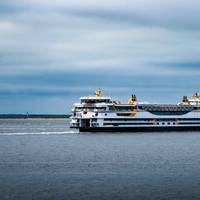
Hybrid RoPax ferry Texelstroom has been delivered to Koninklijke N.V. Texels Eigen Stoomboot Onderneming (Royal TESO). This latest generation symmetrical ferry is powered by efficient, medium speed dual fuel engines of Anglo Belgian Corporation (ABC). Texelstroom will be responsible for transporting up to 1,750 passengers and 350 vehicles between the port of Den Helder and the island of Texel. Royal TESO announced on May 8, 2014 that it had signed an agreement with the northern Spanish shipyard LaNaval for the construction of a new ferry.
Two-Stroke DF Engine Passes Critical Test
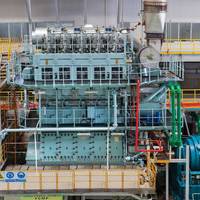
The first Wärtsilä low-speed two-stroke dual-fuel (DF) engine destined for a commercial application has reportedly completed its Factory Acceptance Test (FAT) at a Chinese licensee of Winterthur Gas & Diesel (WinGD), the Switzerland-based designer, developer and licensor of Wärtsilä brand low-speed two-stroke engines. The engine is a five cylinder, 50 cm bore 5RT-flex50DF built by Yuchai Marine Power Co., Ltd. (YCMP) at its factory in Doumen, Zhuhai City, Guangdong Province, in the South of the People’s Republic of China.
Marine Propulsion Technology: Two-Stroke DF Engine Passes Critical Test
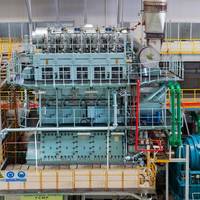
The first Wärtsilä low-speed two-stroke dual-fuel (DF) engine destined for a commercial application has reportedly completed its Factory Acceptance Test (FAT) at a Chinese licensee of Winterthur Gas & Diesel (WinGD), the Switzerland-based designer, developer and licensor of Wärtsilä brand low-speed two-stroke engines. The engine is a five cylinder, 50 cm bore 5RT-flex50DF built by Yuchai Marine Power Co., Ltd. (YCMP) at its factory in Doumen, Zhuhai City, Guangdong Province, in the South of the People’s Republic of China.
Thomson Reuters Recognizes ABB as Top Innovators
ABB has been recognized by Thomson Reuters as one of the world’s top 100 innovators for a third year. This award acknowledges companies around the world for their outstanding commitment to global innovation, the protection of ideas and the commercialization of inventions. “This recognition is a strong endorsement. Innovation is ingrained in the DNA of ABB and a pillar of our Next Level strategy,” said ABB Chief Executive Officer Ulrich Spiesshofer. ABB announced its Next Level strategy in September 2014. The company said it will drive profitable growth through focused initiatives on market penetration, innovation and expansion (PIE). In 2014, ABB announced technology breakthroughs including the development of YuMi, the world’s first robot for full collaboration with humans.
Survitec Liferafts Earn RRR Approval
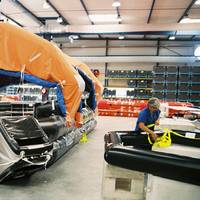
The inland waterways of Russia can now benefit form a new standard of safety equipment following the approval granted to the Survitec Group’s Survitec Zodiac brand by the Russian River Register (RRR). The approval was granted after inspectors from the Register completed a detailed study of the liferafts, escape slides and rescue boats manufactured by Survitec Group under the Survitec Zodiac brand. This included verifying their reliability, manufacturing processes and quality control methods employed at the company’s facility in Chevanceaux, France.
New Hobart Flux-Cored Wires

The newest addition to the Hobart family of AWS E70T-1 welding wires— the Hobart FabCO 70XHP gas-shielded flux-cored wire — offers low fume generation rates to help improve operator comfort and high deposition rates that help increase productivity, the manufacturer said. The new wire complements the FabCO TR-70 and FabCO RXR wires currently offered under the Hobart brand. Together, the three wires provide a continuum of benefits, with the new FabCO 70XHP wire offering the highest level of performance and the lowest visible fume levels.
Wärtsilä to Supply Gas Systems for New Teekay LNG Carriers
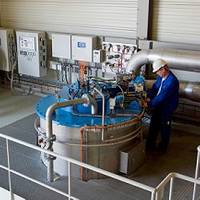
Wärtsilä has been contracted to supply a combined inert gas generator and gas combustion unit for two new liquefied natural gas (LNG) carriers being built at the DSME yard in South Korea. The ships will be owned by Canada based Teekay Corporation, one of the world's largest marine energy transportation, storage and production companies. The contract was signed in May 2013. The concept of combining the two systems was developed by Wärtsilä in cooperation with DSME, and the system burns the boil off gas using an already existing Wärtsilä Moss inert gas generator.
Teekay Order Wärtsilä LNG Inert Gas Units
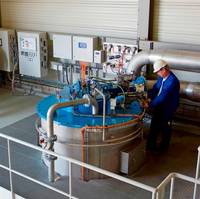
Wärtsilä to supply a combined inert gas generator & gas combustion unit for 2 new liquefied natural gas (LNG) carriers being built at the DSME yard in South Korea for Canada-based Teekay Corp. The concept of combining the two systems was developed by Wärtsilä in cooperation with DSME, and the system burns the boil off gas using an already existing Wärtsilä Moss inert gas generator. In so doing, it eliminates the need for a conventional gas combustion unit thus providing capital expenditure savings for the customer. Delivery of the Wärtsilä equipment is scheduled to begin in autumn 2014.
LNG Tech on tap at Europort 2013
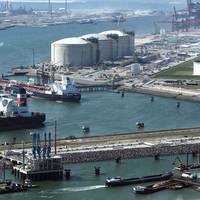
Emissions regulations from 2015 onwards are driving shipowners to a crossroads on fuel selection. Ahead of Europort 2013, Rotterdam, Dutch interests are making significant waves in tangible investments in LNG as a fuel option. While there is not consensus on the potential of liquefied natural gas (LNG) as a marine fuel, the concept is gaining traction rapidly as using LNG reduces nitrogen oxide (NOx) and carbon dioxide (CO2) emissions from ships, as well as allowing operators to meet restrictions set in Sulfur Emission Control Areas (SECAs) today, which tighten from 2015 onwards.
Wärtsilä to Supply FSU, Shuttle Tanker, Inert Gas Systems
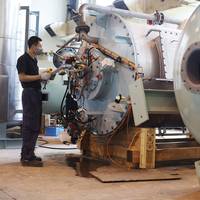
Wärtsilä is to supply inert gas systems for a Floating Storage Unit (FSU) on Norway's Heidrun offshore oil & gas field, and for two supporting shuttle tankers. The FSU is owned by Statoil, the Norwegian state owned energy company, and the tankers by AET Tanker Holdings, the Singapore based petroleum transportation company. All three vessels are being built by Samsung Heavy Industries (SHI) in South Korea. The Wärtsilä contract with SHI was signed in February 2013. Delivery of the Wärtsilä equipment is scheduled for October, 2013.
MAN Dual-Fuel Engines Power Castillo de Santisteban
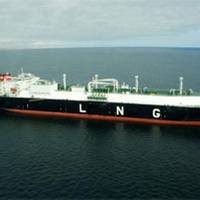
STX Offshore & Shipbuilding, the South Korean shipbuilder, recently delivered the Castillo de Santisteban to Empresa Naviera Elcano, the globally active Spanish shipping group. Five MAN dual-fuel 8L51/60DF engines will power the 984-ft long LNG carrier with each delivering 8,000 kW at 514 rpm. The newbuilding has been assigned by her charterer, Spanish energy company Repsol – Gas Natural LNG (Stream), to the Peruvian Camisea/Pampa Melchorita gas project, the first natural-gas liquefaction plant in South America. The carrier has a carrying capacity of 173,600 m3 LNG.
Updated Flow Rate Analysis from BP’s Well
Under the direction of National Incident Commander Admiral Thad Allen, the Flow Rate Technical Group (FRTG), which is led by United States Geological Survey Director Dr. Marcia McNutt, and a scientific team led by Energy Secretary Steven Chu are analyzing new data and bringing together several scientific methodologies to develop an updated estimate of how much oil is flowing from BP’s leaking oil well in the Gulf of Mexico. The updated estimate, which will bring together the ongoing work of scientists and engineers from the federal government, universities, and research institutions, will be of how much oil has been flowing since the riser was cut on June 3.
Divex Introduces HeliCom for Diver Comms

International diving equipment technology company Divex announced the launch of a communication system for the saturation diver. Divex, headquartered in Westhill, Aberdeen, Scotland launched HeliCom, the Helium Speech Unscrambler Communication System. Saturation divers use helium as the major component of the special breathing-gas mixture called heliox (a mixture of helium and oxygen). One of the disadvantages of helium is the "Donald Duck" effect on the voice which complicates the communication process.
Wärtsilä's Dual-Fuel Engine Power Module for FPSO Upgrade
Wärtsilä Corporation has supplied a 5,800 kW Power Module to Bergesen d.y. Offshore AS, Norway, for installation on board the FPSO vessel Berge Hus. The Module, which is powered by a Wärtsilä 18V32DF dual-fuel engine, will burn produced gas. Currently being converted into an FPSO vessel from a VLCC tanker at the Jurong shipyard in Singapore, Berge Hus is destined for operation on the Ceiba oil field off Equatorial Guinea. Oil was reached in the Ceiba field by another Bergesen FPSO vessel, the Sendje Berge, in November 2000. The sister ship Berge Hus will take over work on that field in the first quarter of 2002 to complete the planned 10 production wells and four water injection wells, and continue handling the crude oil produced from the field.
Wärtsilä Dual-Fuel Engines for 153,000 m3 LNG Carrier
Wärtsilä Corporation has been awarded a contract by the French shipbuilder Chantiers de l'Atlantique to supply dual-fuel main engines for a new 153,000m3 LNG carrier. The LNG carrier has been ordered by the French gas distributor Gaz de France for delivery in October 2005. It will be employed in the shipment of liquefied natural gas (LNG) from Norway or Egypt, but is also designed for the alternative of trading on the spot market. The vessel will have gas-electric propulsion, with four dual-fuel engines driving generators to supply electricity for the single propeller plant. The engines will burn boil-off cargo gas with a small quantity of liquid fuel for ignition. They will mainly can run on gas with liquid fuel as back-up, and can be switched over automatically as the need arises.
Gas Ships: Dual-fuel Diesel Engines for LNG Carriers
Recent orders for Wärtsilä 50DF dual-fuel engines for two LNG carriers, eight engines in all, are no coincidence. This engine type promises benefits for LNG operators including larger cargo capacity, lower fuel consumption, higher flexibility in operation, and lower emissions. Gaz de France is the first to take the plunge. Until now, steam turbines have dominated as propulsion machinery for LNG carriers, with their apparent reliability and the ease with which they can burn the boil-off gas from the ship's cargo tanks while at sea. The low fuel efficiency of steam turbines, however, has already encouraged almost all other shipping segments to switch to diesel-powered ships.
Wartsila Awarded Contract
shipyard Chantiers de l'Atlantique. Due for delivery in 2004, this newbuilding is breaking away from traditional practices in the propulsion of LNG (liquefied natural gas) carriers. It will be the first LNG carrier to be powered by electric propulsion, and one of few to have internal-combustion engines instead of the more usual steam turbine plant. The four dual-fuel engined generating sets will meet all the ship's propulsion and shipboard electrical requirements. engines each develop 5700 kW at 514 rev/min. This membrane-type vessel (GTT-CS1) will be employed transporting LNG from Skikda in Algeria to Fos near Marseilles. take about one week at a service speed of 16 knots, which can be achieved with three of the four generating sets.
Wärtsilä's Dual-Fuel Engined Power Module For FPSO Upgrade
Wärtsilä Corporation has supplied a 5,800 kW Power Module to Bergesen d.y. Offshore AS, Norway, for installation on board the FPSO vessel Berge Hus. The Module, which is powered by a Wärtsilä 18V32DF dual-fuel engine, will burn produced gas. Currently being converted into an FPSO (floating production, storage and offloading) vessel from a VLCC tanker at the Jurong shipyard in Singapore, Berge Hus is destined for operation on the Ceiba oil field off Equatorial Guinea. Oil was reached in the Ceiba field by another Bergesen FPSO vessel, the Sendje Berge, in November 2000. The sister ship Berge Hus will take over work on that field in the first quarter of 2002 to complete the planned ten production wells and four water injection wells…
Hyundai, MAN B&W Are At Top of Engine Power
Rising Korean aspirations as to market influence and technological standing could alter the established order in an important segment of the engine business. While MAN B&W announced opening contracts for its new L21/31 design as a marine auxiliary, Hyundai Heavy Industries was preparing to roll-out its first-ever, self-originated engine type targeted at a similar power range. The H21/32 signals the emergence of Hyundai, the world's largest producer of marine diesels, as a designer in its own right. The company's development of the in-house Himsen brand denotes a move towards increased technological self-reliance, given the wholesale dependence up until now on manufacturing licenses from foreign engine firms.
First Wärtsilä Marine DF Engines Ordered
Wärtsilä Corporation has received the first order for Wärtsilä 32DF marine engines. PGS Production in Norway has contracted for two Wärtsilä 18V32DF engines to be installed in the FPSO (floating, production, storage and offloading) vessel "Petrojarl I". The two engines, each developing 3,720 kW at 720 rpm, will be supplied as complete generating sets. They will burn wellhead gas. Built specifically as an FPSO vessel for North Sea service in 1986, the "Petrojarl 1" has been fitted with various additional equipment over the years. The two Wärtsilä-engined sets will therefore add necessary electricity generating capacity. They are currently being installed during a planned major drydocking before the vessel takes up a three-year contract on the Glitne field in the North Sea.





